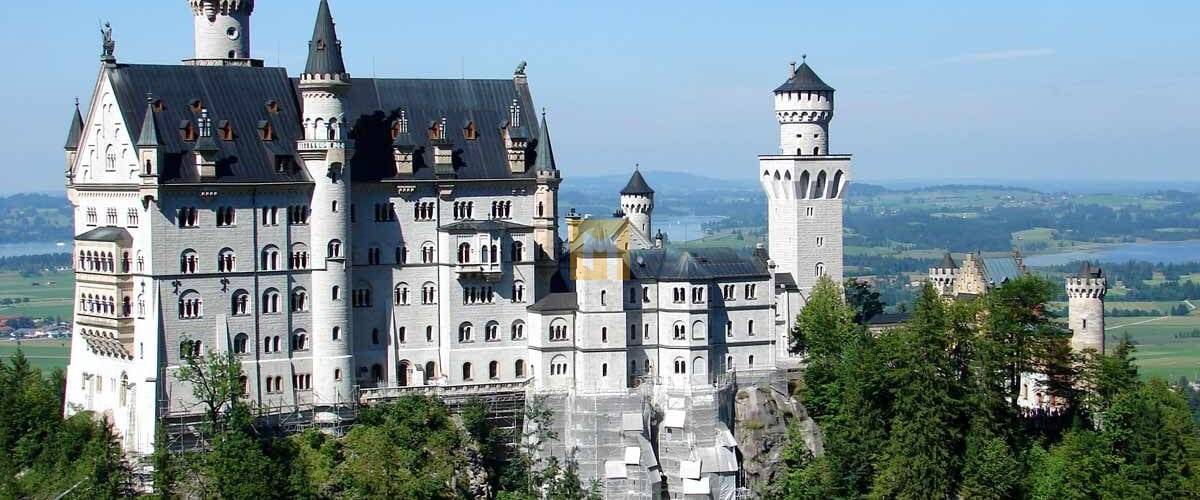
EXPLORING GERMANY’S ‘ROMANTIC ROAD’ BY TRAIN
Germany’s so-called “Romantic Road” is a popular tourist attraction in the southern states of Baden-Württemberg and Bavaria.
It is loosely based on the ancient Roman route and includes visits to several beautiful walled towns, historic towns and beautiful castles.
The much-loved route begins in Wurzburg, located in the center of the important wine region, and ends in Fussen with the majestic Alps rising behind the historic city.
BY TRAIN, BUS, CAR, AND BIKE OR ON FOOT:
The Romantic Road can be traveled on foot (yes, maps and guided tours are available – to cover part or all of the 400-kilometer route), by bicycle (using the connecting cycle paths), and by bus or car.
The hop-on hop-off bus service even allows you to complete the route at your own pace, so you can decide to hop off and stay at a particular destination, then hop on another bus and continue your journey when you’re ready to do it, but I decided to take the train.
After all, I had a Eurail pass, so it seemed like the best, and while the train doesn’t go directly to every small town along the way, it certainly provides easy access to major destinations.
GATEWAY TO THE ROMANTIC ROAD:
I began my journey through Germany by train from Wurzburg, often referred to as the “Gateway to the Romantic Road,” with a visit to the Residenz Palace and Marienberg Fortress, once the two main residences of the city’s Prince-Bishops.
The fortress sits atop a hill with vineyards in front of it, so it makes for a great photo op. However, I particularly loved the Residenz (a castle built between 1720 and 1744) as it has beautiful courtyard gardens (very popular for taking wedding photos) and a beautiful staircase – and the largest ceiling painting. World.
I also found a hospital in Wurzburg, founded by Prince-Bishop Julius in 1576, which was also a winery – a giant cellar under the sanatorium with about 4 million liters of wine.
BY TRAIN TO ROTHENBURG, GERMANY BY TRAIN:
I then traveled by train to Rothenburg ob der Tauber (Red Castle on the River Tauber), one of the most beautiful medieval walled towns in Europe.
I was able to walk through much of the city atop the massive stone walls and enjoy the view of the city’s red-roofed buildings and soaring church spires.
I also visited the famous St. James (Lutheran) Church of Rothenburg, which has a beautiful altarpiece and stained glass windows of the Twelve Apostles (circa 1400) – and went down below the town hall to see the old dungeons, which once housed the city’s mayor. Dead too!.
While in Rothenburg I also went on a fascinating ‘night watchman tour’ and the watchman explained a lot about the history of the town as we were guided through the streets of the walled city.
This tour was both informative and entertaining and as we neared the end of the walk we passed a medieval tavern called Hoell (hell).
The night watchman joked that “he was once told ‘go to hell’ and it wasn’t that bad”. He even admitted, “I liked it better.”
AUGUSTA TO GERMANY BY TRAIN:
After exploring Rothenburg, it was back on the train – to Augsburg – an even older settlement, founded over 2,000 years ago.
Here I visited the Town Hall (with its Golden Hall), the Maximilian Museum (where an enclosed courtyard houses three famous Renaissance fountains), the Church of Sant’Anna, a Protestant church with a Roman Catholic crypt, and the Fuggeri. , said to be “the oldest social settlement in the world”.
There is a lot of history to discover here, with many museums housed in old churches, including the Museo Romano.
The town hall also has a small but informative historical overview with old objects that you can really touch.
MY TRIP TO FUSSEN ENDS:
I concluded my train journey in Füssen, it’s hard to imagine a more wonderful setting for the Romantic Road finale.
This small village is home to the oldest fresco painting in all of Germany – in the crypt of the Basilica of San Mang (dated 980) – and is close to some of the country’s most famous and fascinating castles, including the childhood home of Ludwig II , Hohenschwangau and Ludwig . II, the famous Neuschwanstein creation, which became Walt Disney’s inspiration for Sleeping Beauty Castle.
Of course, I just had to see these magnificent castles in person, and I was particularly impressed by the dazzling beauty of Neuschwanstein. It really looked like something out of a fairy tale! It sits high on a barren rock against the backdrop of the snowy alpine landscape of the Alps.
As I approached this castle I decided to take a shuttle bus high above Neuschwanstein – and then walk a relatively short hiking trail up to the Marien bridge – which had the best views of the castle – and down into the gorge. Far below – with its magnificent waterfall.
REQUEST GERMAN ROUTE BY TRAIN:
You can of course go both ways on the romantic road, but I recommend starting in Würzburg and ending in Füssen. The route will be historically fascinating and the scenery unforgettable.
To experience the best of Germany by train, buy an Interrail pass here before you go. You will find significant savings and several options. The best deal for you if you are traveling alone in Germany is the German train ticket.